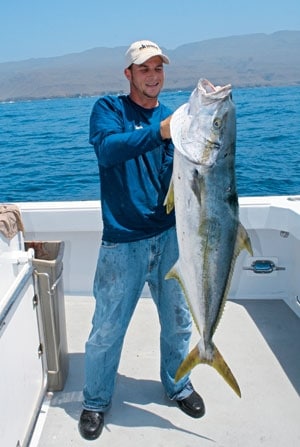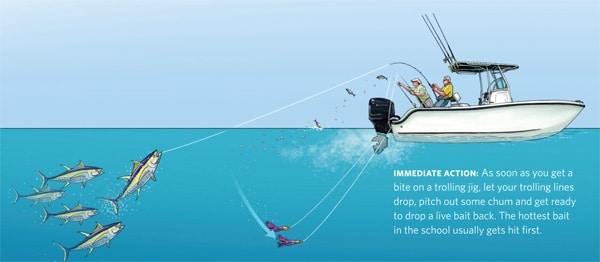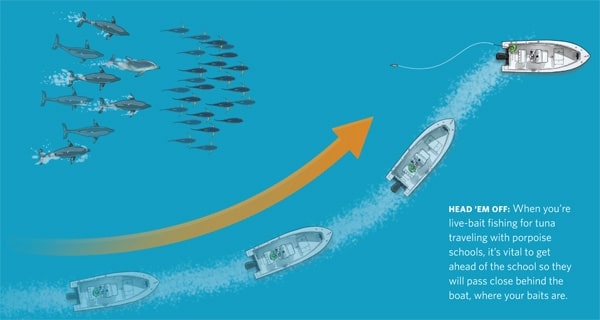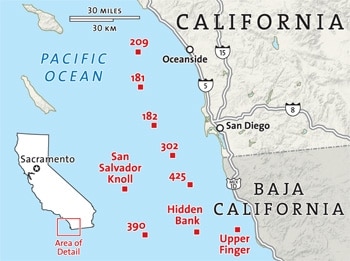
There are a couple of near certainties about fall offshore fishing in Southern California and Mexico’s northern Baja waters. The weather is usually on its best behavior, allowing even private skiffs to venture far from port in search of bait schools, temperature breaks, and the tuna associated with dolphin schools and floating kelp paddies. And there seems to be a lot less boat pressure, making it easy to get away from the crowds and on the fish, even during normally busy weekends.
What exactly might be on the offshore menu can be a little less predictable. Traditionally, albacore and bluefin reliably move into the range of one-day boats and private boats (loosely defined as 50 miles or closer) around July 4, when water temps reach the mid-60s, and then as the water warms up, they are replaced by other pelagic species, like yellowfin tuna, dorado and yellowtail. As this was written, summer 2010 had delivered a start-and-stop albacore and bluefin bite and a solid wall of cold, off-color water – referred to by skippers as the “green door” – that kept the tuna south and west of the Southern California coast. When the door opened up momentarily, boats enjoyed some epic but short-lived bites on longfins and mixed bluefin. San Diego long-range boats reported large schools of tuna down the Baja coast, which bodes well if conditions normalize and permit the usual northward migration patterns.

By Joe Mahler / www.markerjockey.com
Bank On Variety
All this makes it hard to predict what fall 2010 will serve up for Southern California anglers. Fishermen targeting offshore banks, ridges and high spots could be tangling with albacore and bluefin long into the fall. Or conditions could straighten out and allow yellowfin, dorado and yellowtail to invade these areas and switch the game to warm-water action. It’s also possible we could enjoy a mixed bag, catching albacore, yellowfin, yellowtail and dorado on the same trip.
There are a variety of techniques anglers use to target these fish when they move within range of popular southern marinas like Dana Wharf, Oceanside and San Diego; all can be effective depending on conditions on a given day. But the first thing anglers must do is locate fish in the vast expanse of open ocean.
When targeting pelagics, top skippers fish “the edge” – which is roughly any location where two different conditions come together. This could be an edge between cooler and warmer water, which tends to corral schools of baitfish and separate species of game fish based on their temperature preferences. It could be a kelp paddy bobbing up and down on the swells, serving as a hiding place for forage and a fast-food rest stop for hungry tuna, yellowtail and dorado. Even schools of anchovies, sauries or sardines in open water represent an edge of sorts because they represent something different in a vast tract of featureless ocean.
Ocean floor topography has a lot to do with creating these different types of sought-after edges. Undersea canyons, ridges and pinnacles create currents and nutrient-rich upwellings, so anglers often focus efforts over well-known high spots (named for the depth in fathoms) like the 209, 181, 182, 302, 425 and 390, as well as bottom features like the Hidden Bank, San Salvador Knoll, Upper Finger and Butterfly.
Trolling
Trolling is one of the easiest and most productive ways to target offshore fish. It allows you to cover large areas while searching for birds, jumping tuna, surface-rippling bait or floating kelp paddies, so you’re always fishing. Popular tuna feathers like Sevenstrand Tuna Clones and Zuker’s jigs are effective on all offshore species when trolled at 6 to 8 knots on the third wake back. The venerable wooden cedar plug – which looks like nothing more than a stick with a large single hook in it – is especially deadly on albacore and yellowfin tuna. Because most private boaters troll with the hopes of finding and catching fish on live bait, we use heavy gear to bring the school to the boat quickly and usually don’t mess around with outriggers, birds, spreader bars or other trolling paraphernalia.
When you see the right signs but fish seem reluctant to rise to the jigs, try trolling diving or swimming plugs like Rapala Count Down 14s and 18s or MirrOlure 113MRs. These lures are best trolled slightly slower, from 4 to 6 knots.
Darker colors, such as green-and-black, purple-and-black and root beer, are usually most effective in the morning and evening and on overcast days. On bright days and during midday, anglers turn to brighter lure colors like Mexican flag, zucchini and chartreuse to get bit.

By Joe Mahler / www.markerjockey.com
**Live Bait
**When you get a jig strike, you want to get a few pieces of live chum and hooked, fly-lined baits in the water as soon as possible. Albacore and yellowfin tuna will usually follow the hooked fish toward the boat, and the idea is to intercept them. Getting a bait in the water fast is more important than bringing in the trolling lines, so just let them sink.
Live-bait selection is critical, and the old saying is that you want the bait you can’t catch. The best sardines or anchovies are light green and slimy to the touch. Hook the bait crossways through the nose (or under the collar for anchovies), and make a gentle lob cast behind the boat. Let the bait swim freely; the hot bait that peels away from the boat is usually the one that gets hit. When you feel a fish grab your bait, count to three and lock up the reel.
Paddy Fishing
Kelp paddies are like gold in the fall. Although yellowtail and dorado can be caught on blind jig strikes, they are most fre-quently taken on one of these floating mats of kelp. Yellowfin tuna and albacore also swim in the vicinity of paddies, attracted by the baitfish seeking some sort of shelter in the open water. I’ve even hooked striped marlin while casting live bait near a paddy.
Often anglers make the mistake of thinking they have to put the bait right on the kelp, as if the fish were hiding under it. Instead, position the boat to drift past the kelp about 75 to 100 feet off your stern. If you hook up, apply plenty of pressure to keep the fish away from the kelp; yellowtail in particular will head for the safety of structure.
Paddies are also great places to go deep, either with live bait or a heavy iron jig. You can get a sardine or anchovy deep by tying a 1- to 2-ounce torpedo sinker in line with the bait. Or try dropping a heavy chrome or blue-and-white iron down 100 feet and winding it yo-yo-style toward the surface. Crank as fast as you can; you will never outrun a hungry yellowtail, tuna or dorado.
Slow-Trolling
Slow-trolling with live bait is a tactic vastly underutilized by offshore fishermen. If you still see signs of life (boils, dipping birds) around after you land a fish, don’t leave right away to resume the troll. Drop a couple of nose-hooked sardines way behind the boat, and cover some water at idle speed. Keep your reel in free-spool, and control the bait with thumb pressure. You can often reacquire the school this way. Likewise, you should never leave a productive kelp paddy without first slow-trolling a large circle around it.
Working the Dolphin
The past couple of fall seasons have provided Southern California anglers with the chance to target yellowfin tuna on pods of common dolphin. This has to be one of the most exciting ways for private boaters to fish, chasing down jumping dolphin and racing to get into position.
When the yellowfin are on the dolphin, target the tuna by trolling or with live bait. Trollers are usually limited to working the edges of the dolphin pod and occasionally cutting across the leading edge of the group to intercept the fish below.
The tuna are generally ahead of the visible dolphin, so bait fishermen need to get far enough ahead to shut down the boat and get live baits in the water. If everything goes according to plan and the pod crosses close enough behind your stern, a hungry tuna will inhale every live bait. If the dolphin change course and veer off in a different direction (as they often do), you need to reel in, fire up and try again.
Trip Planner
**

What:** Albacore, yellowfin tuna, yellowtail and dorado.
When: September until the first winter storm.
Where: Popular offshore high spots from Catalina Island to below the Mexican border (special permits required for Mexican waters). Popular launching spots include Newport Harbor, Dana Wharf, Oceanside, Mission Bay and San Diego Harbor. For GPS coordinates of the popular high spots on the map below, visit tempbreak.com.
Rods: 7-foot medium-action conventional rod rated for 15- to 40-pound-test for live bait or a jig; Heavy-action 512- to 6-foot rod for trolling.
Reels: High-speed star- or lever-drag conventional reel appropriate for 20- to 30-pound monofilament; size 4/0 to 6/0 lever-drag reels for trolling.
Lines: 20-, 25- or 30-pound monofilament. Use a 3-foot fluorocarbon leader when the fish are line-shy.
Hooks: Live-bait hook sized to match bait, No. 4 or No. 2 for anchovies, 2/0 to 3/0 for sardines.
Lures: Zuker’s jigs, Sevenstrand Tuna Clones and other small tuna feathers; cedar plugs; or lipped diving plugs. For fishing deep on paddies, heavy butterfly and other similar jigs can be deadly.









